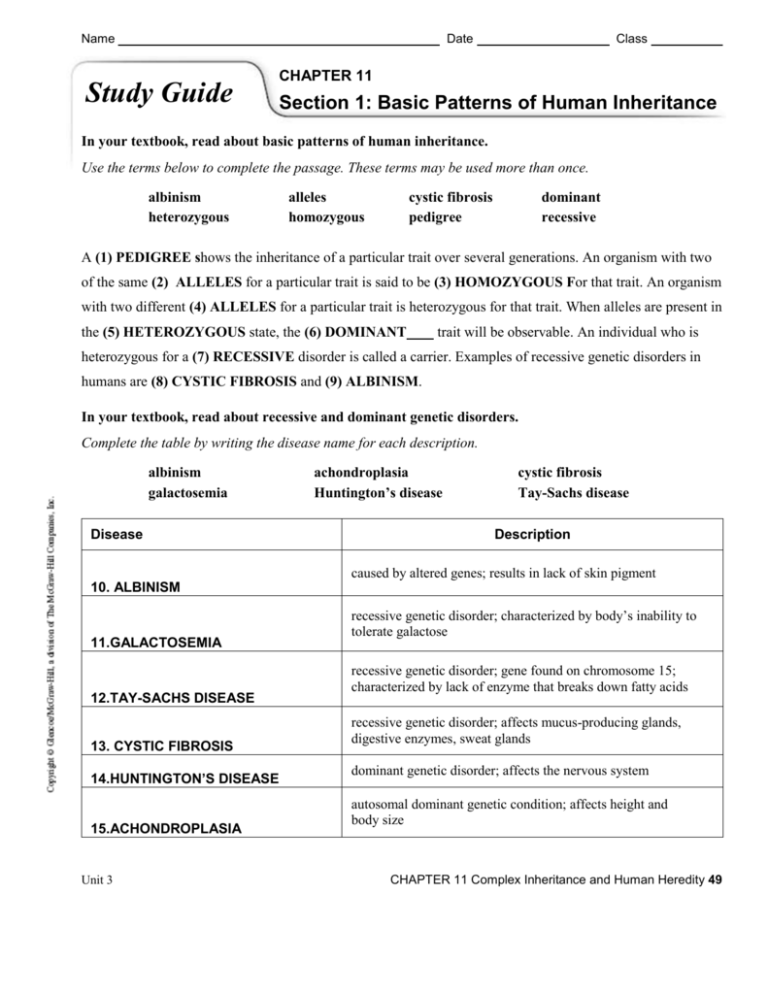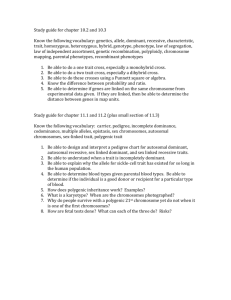Human Inheritance Study Guide: Genetics & Heredity
advertisement

Name Date Study Guide Class CHAPTER 11 Section 1: Basic Patterns of Human Inheritance In your textbook, read about basic patterns of human inheritance. Use the terms below to complete the passage. These terms may be used more than once. albinism heterozygous alleles homozygous cystic fibrosis pedigree dominant recessive A (1) PEDIGREE shows the inheritance of a particular trait over several generations. An organism with two of the same (2) ALLELES for a particular trait is said to be (3) HOMOZYGOUS For that trait. An organism with two different (4) ALLELES for a particular trait is heterozygous for that trait. When alleles are present in the (5) HETEROZYGOUS state, the (6) DOMINANT trait will be observable. An individual who is heterozygous for a (7) RECESSIVE disorder is called a carrier. Examples of recessive genetic disorders in humans are (8) CYSTIC FIBROSIS and (9) ALBINISM. In your textbook, read about recessive and dominant genetic disorders. Complete the table by writing the disease name for each description. albinism galactosemia Disease achondroplasia Huntington’s disease cystic fibrosis Tay-Sachs disease Description caused by altered genes; results in lack of skin pigment 10. ALBINISM 11.GALACTOSEMIA 12.TAY-SACHS DISEASE 13. CYSTIC FIBROSIS 14.HUNTINGTON’S DISEASE 15.ACHONDROPLASIA Unit 3 recessive genetic disorder; characterized by body’s inability to tolerate galactose recessive genetic disorder; gene found on chromosome 15; characterized by lack of enzyme that breaks down fatty acids recessive genetic disorder; affects mucus-producing glands, digestive enzymes, sweat glands dominant genetic disorder; affects the nervous system autosomal dominant genetic condition; affects height and body size CHAPTER 11 Complex Inheritance and Human Heredity 49 Study Guide, Section 1: Basic Patterns of Human Inheritance In your textbook, read about patterns of inheritance. For each statement below, write true or false. T 16. A scientist uses a pedigree to study family history. F 17. A pedigree traces the inheritance of a particular trait through only two generations. F 18. In a pedigree, one who does not express the trait is represented by a darkened square or circle. T 19. In a pedigree, a horizontal line between two symbols shows that these individuals are the parents of the offspring. T 20. Individual II1, as shown below, is in generation II. Refer to the pedigree above. Respond to each statement. 21. Recall if the trait is recessive or dominant based on the following information: In the pedigree, individuals I1 and I2 are unaffected but have an affected child. RECESSIVE – PARENTS ARE HETEROZYGOUS FOR THE TRAIT - CARRIERS 22. Specify if parents II1 and II2, who have an affected child, are carriers of the trait. YES THEY ARE CARRIERS FOR THE RECESSIVE DISORDER 23. Tell whether there is a dominant gene in the genotype of II4. YES – BECAUSE THEY DO NOT HAVE THE DISORDER. 50 Complex Inheritance and Human Heredity CHAPTER 11 Unit 3 Name Date Class CHAPTER 11 Study Guide Section 2: Complex Patterns of Inheritance In your textbook, read about incomplete dominance. Complete the table by checking the correct column(s) for each description. Reminder: R is dominant (normal red blood cells). r is recessive (sickle-shaped red blood cells). 24.RR RR Rr 25.Rr rr 26.rr In your textbook, read about sex-linked traits. Refer to the Punnett square. Respond to each statement. XB Y XB XBXB XBY Xb XBXb XbY Reminder: A female has 2 X chromosomes. A male has an X and a Y chromosome. B is dominant (normal color vision). b is recessive (color blindness). 27. Tell if the father has color blindness. NO FATHER HAS NORMAL VISION 28. Specify if the father has a recessive allele. NO, ONLY THE DOMINANT ALLELE ON THE X CHROMOSOME FOR THE FATHER 29. State whether the only child that could have color blindness is male or female. MALE – XY Unit 3 CHAPTER 11 Complex Inheritance and Human Heredity 51 Study Guide CHAPTER 11 Section 3: Chromosomes and Human Heredity In your textbook, read about chromosomes and human heredity. Match the definition in Column A with the term in Column B. Column A Column B A 30.micrograph of chromosomes A. karyotype D 31.abnormal number of chromosomes B. Down syndrome E 32.missing one X chromosome C. telomere B 33.extra chromosome 21 D. nondisjunction E 34.protective cap at the end of a chromosome E. Turner’s syndrome F______ 35. Individual with 2 X chromosomes & a Y F. Klinefelter’s syndrome KARYOTYPE INSTRUCTIONS: Using the karyotype to the right answer the following questions. 36. Is this a normal karyotype?__NO_______ 37. If you answer was no, name the disorder. KLINEFELTER’S______ 38. If there are extra chromosomes in this karyotype, what caused this to happen? (Hint it is one of your vocab words)__NONDISJUNCTION_________________________________ 39. What is the sex of this individual? _MALE – HAS Y CHROMOSOME____________ 40. What is the name of the disorder that involves an individual with only 1 X chromosome? _TURNER’S SYNDROME____ Is this individual a boy or a girl? __________ 41. What is the probably that an offspring will be male? ___50%____________________ 42. For a normal karyotype, how many chromosomes would you see? _46 OR 23 PAIRS__ 43. Name at least 4 things that are shown in a karyotype. _SEX OF OFFSPRING, GENETIC DISORDERS, # OF CHROMOSOMES, AUTOSOME & SEX CHROMOSOMES PUNNETT SQUARES: set up & complete the following Punnett Squares in order to answer the questions. IB IA i I A IB IB i IA i i i i 44. What blood types would a man & a woman have to have if they have one child with A blood, 1 child with B blood, 1 child with AB blood, and one child with O blood? GENOTYPE FOR MAN __ IA i_____ GENOTYPE FOR WOMAN __ IB i _______ 45. Write all the possible genotypes for A blood. __ IA i ____ IA IA ________________ 46. Write all the possible genotypes for B blood. __ IB i _ IB IB __________________ 47. Write all the possible genotypes for AB blood. ___ IA IB ________________________ 48. Write all the possible genotypes for O blood. __ii______________________________ N N n n NN Nn Nn nn 49. Tay-Sachs is a recessive disorder disease. Both parents are carriers. What is the probably they will have a child with Tay-Sachs? ___25%_______________________ P p p p Pp pp Pp pp 50. Polydactyly is a dominant disorder. Dad has the disorder, but mom does not. 3 of their 4 children also have the disorder. What genotype is dad? __Pp_____________________ DEFINITIONS: 50. AUTOSOME: CHROMOSOME THAT IS NOT A SEX CHROMOSOME 51. BARR BODY: INACTIVATED X CHROMOSOME 52. INCOMPLETE DOMINANCE: COMPLEX INHERITANCE PATTERN IN WHICH THE HETEROZYGOUS PHENOTYPE IS INTERMEDIATE BETWEEN THOSE OF THE TWO HOMOZYGOUS PARENT ORGANISMS (BLENDED LIKE PAINT) 53. POLYGENIC: CHARACTERISTIC, SUCH AS EYE COLOR OR SKIN COLOR, THAT RESULTS FROM THE INTERACTION OF MULTIPLE GENE PAIRS. 54. SEX-LINKED TRAITS: CHARACTERISTIC, SUCH AS RED-GREEN COLOR BLINDNESS, CONTROLLED BY GENES ON THE X CHROMOSOME; ALSO CALLED AN X-LINKED TRAIT.









